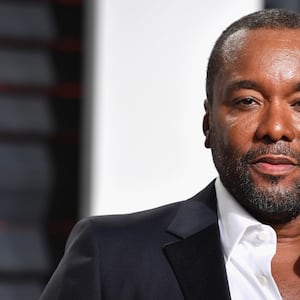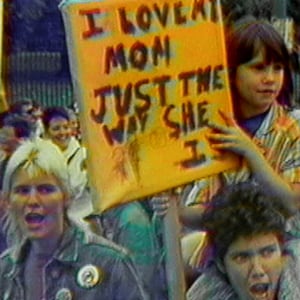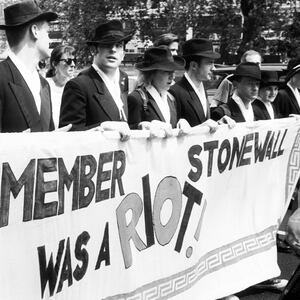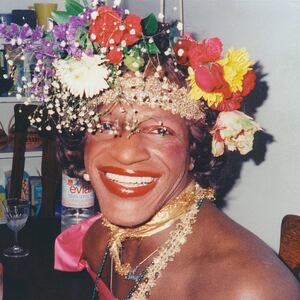In a few weeks, it will have been 50 years—half a century—since the Stonewall Riots in 1969 fueled a fire of LGBT resistance that’s been celebrated every single year since.
Late on a Friday night in the summer of 1969 (technically a Saturday morning around 1 a.m.), a “series of violent protests and street demonstrations” flared up outside the Stonewall Inn, an illegal gay bar in New York City's Greenwich Village.
So summarizes David Carter in Stonewall: The Riots That Sparked the Gay Revolution, the 2004 book considered to be the quintessential guide to Stonewall. The riots spanned six days and included three nights of so-called rioting between police and a diverse community of LGBTQ+ protesters. On the first night, the same police that had shown up to harass patrons, arrest a few gay people, and collect some cash, were overwhelmed.
They soon retreated into the very bar they had targeted and barricaded themselves inside, waiting for reinforcements to arrive and fighting off a barrage of coins, bricks, trash cans, and even a parking meter.
After help came, protesters were fought off, beaten, and a few were taken in. During those six days, police arrested 21 people. No one died during the riots—except for the Stonewall Inn itself, which soon after shut down and remained dormant for decades.
Within a matter of weeks, fallout from the riots tore through existing pro-LGBT, or—in the language of that era—homophile, organizations. Trailblazing radical groups formed with unprecedented demands for equality. Freshly minted LGBT magazines popped up, attracting tens of thousands of readers. Police raids continued, as did the abject criminality of queerness, but the breadth of resistance was increasing by the hour.
“By the early 1970s, the number of gay and lesbian organizations soared to nearly four hundred,” historian and scholar Eric Marcus wrote in Making Gay History: The Half-Century Fight for Lesbian and Gay Equal Rights. The first Pride march (on what was then called Christopher Street Liberation Day) came just one year after the riots to commemorate them.
It drew thousands across cities like San Francisco, New York, and Los Angeles. Protests in those same cities became “commonplace,” Marcus wrote, ranging from kiss-ins at restaurants that wouldn’t serve LGBT would-be patrons to “on-air interruptions of national news programs.” By 1972, Democratic presidential hopefuls “spoke favorably” of federal anti-discrimination protections.
The LGBT movement had phoenix-ed nearly overnight, the Stonewall episode today widely considered “the birth of the modern gay and lesbian political movement,” Martin Duberman wrote in Stonewall: The Definitive Story of the LGBTQ Rights Uprising that Changed America. First published in 1994 (the 25th anniversary of the riots), the book’s second edition was released on June 4.
And yet, the details of the riots and what precipitated them have become, as Carter puts it, “a bone of contention between various individuals and interest groups within and without the gay world.” What kind of gay bar was Stonewall? What was a gay bar in 1969 like, anyway? Who went there? Who didn’t? Who protested? Who started it? Who threw the first brick? Was it the launching pad of the LGBT cause? Is it the source of capital P Pride? And what the hell is a modern political movement?
“There was no omniscient presence looking down at the scene,” Marcus told me, adding that the largely (if not wholly) anecdotal approach to deciphering Stonewall is problematic. “Memory is what we remember, how we wish to remember it, and how we wish to be remembered in it.”
And besides, Duberman tells me before laughing, “everyone was stoned.”
LGBT AMERICA BEFORE STONEWALL
The creator and host of a podcast named after his book (whose fifth season is releasing this month) and founder of the Stonewall Consortium, Marcus also co-created a factsheet that attempts to dispel some of the misconceptions around the riots. Before considering those, it’s instructive to consider what LGBT America faced in the 1960s, which histories like Carter’s, Marcus’, and others help us understand.
Being gay was illegal or, to put it more harshly, a crime
That was the case at the time in every state except Illinois and could result in life in prison, Carter tells us. Different states had varying degrees of punishment. In California, for example, men found to have had sex with other men were “given electrical and pharmacological shock therapy, castrated, and lobotomized.”
By 1961, anti-gay laws in the US were “harsher on homosexuals than those in Cuba, Russia, or East Germany,” all objects of American criticism for “their despotic ways,” Carter notes.
During a launch event in 2004 for Carter’s tome about Stonewall, the police officer who led the Stonewall raid the night of the riots, the 89-year-old Seymour Pine, apologized. He told a crowd that “the police of the era were biased against gays,” reported the Villager. “They certainly were prejudiced. There was no question about that,” the article quotes him saying. “But they had no idea about what gay people were about.” Pine died a few years later in 2010.
Fifteen years following that, and nearly a decade after Pine died, the current police commissioner of the NYPD James P. O’Neill took a stab at his own apology earlier this month, saying what happened “should not have happened” and that ignoring that fact during World Pride Month would be “irresponsible.”
“The actions taken by the NYPD were wrong, plain and simple. The actions and the laws were discriminatory and oppressive, and for that, I apologize,” O’Neill told an auditorium of people on Thursday, June 6. “I vow to the LGBTQ community that this would never happen in the NYPD in 2019. We have, and we do, embrace all New Yorkers.”
Being gender-non-conforming in New York City was functionally illegal, too
An old antilabor regulation got “dusted off” and allowed police to arrest people who wore “fewer than three articles of clothing appropriate to their sex,” Carter found, often a pretense to lock up the men, women, and gender-non-confirming patrons of the Stonewall and other LGBT bars in the area.
Legalization of alcohol and post-World War II Puritan values proved a terrible combination for queer people
Since the post-prohibition creation of over-correcting agencies like the State Liquor Authority (SLA), bars weren’t really able to serve LGBT patrons at the risk of getting shut down. Why? Gay people were considered “lewd and dissolute,” Carter wrote, so their very presence could bucket any bar as “disorderly” and therefore a target of the SLA.
The mafia operated the Stonewall Inn and other LGBT bars in the area
Enter organized crime, swooping in to exploit LGBT patrons and pay off the police for the privilege to do so. In 1966, one Tony Lauria, a young Mafioso nicknamed “Fat Tony,” bought the Stonewall specifically for that purpose. He paid the police around $1,200 a month to let him keep it open, according to Carter. That’s nearly $9,500 a month in 2019 dollars (and the rent in the area is a bit more expensive today).
The Stonewall Inn was far from swanky. There was no running water at the main bar and therefore no way to clean glasses. Sinks filled with standing water in the back served as dumping grounds for used glasses. When needed, those glasses were then fished out of their tubs, dried, and reused. The drinks were often diluted. And the building had no fire exits.
But that wasn’t the worst of it. “Research on this book uncovered a couple of elusive references to a prostitution ring that was run on the second floor above the Stonewall Inn,” Carter writes. “When one looks at all the available evidence today, there is little doubt that such a ring operated out of the floor above the Stonewall Inn, although few knew it existed.”
There’s no definitive proof either way, Carter admits about the following, but says he conclusively believes commissioner Pine’s claims that “he was ordered to put the Stonewall Inn out of business because it was being used as a site to blackmail gay men who worked in the Wall Street area.”
After gathering identifying personal information about patrons both in the bar portion of Stonewall and its upstairs activities, the blackmailers would then assess the potential earnings of extorting those men and sometimes threaten to expose them, which would functionally destroy their lives. None of this was uncommon at the time, and a 1969 excerpt from the New York Mattachine Newsletter, which mentions Stonewall by name, carries an explicit warning:
“We caution our readers NEVER to use your real name when cruising, NEVER to give your address to a questionable bar or club, and remember, that trick or hustler you’ve just picked up may be ‘working’ for the management!”
None of this stopped people heading to the bar. The Stonewall Inn was popular and Friday nights were, as they are now, a great time to grab a drink. Besides, Duberman told me, laughing again, Stonewall was the “best gay bar in town for dancing,” even if it was sometimes considered “upper class and uptight.” And he would know: He was there, “one of those upper class and uptight people.”
STONEWALL CERTAINTIES: WHAT WE KNOW
Police raids on LGBT bars were common, generally low-key, and anticipated. There was even a raid at the Stonewall a few weeks prior to June 28 (which some credit with fanning the flames of that night’s opposition). However, in an attempt to win political favor at the time with crime-busting candidates and in somewhat breaking this cycle, Seymour Pine and his officers did not alert the Stonewall Inn on June 28 of their impending arrival.
The Stonewall Riots spanned six days, beginning around 1 a.m. the morning of Saturday June 28, 1969.
Police made 21 arrests, all told. The first night saw 13 arrests and the second night, Saturday, saw three.
“Sunday, Monday, and Tuesday nights remained relatively calm,” Carter wrote, partially crediting the police for having made a few productive conclusions: More cops are better than less. Showing up early is better than showing up later. And behaving apathetically is better than spitting slurs or inciting excitement. Besides, Carter adds, “the weekend had passed.” Most people couldn’t keep at it when Sunday rolled around, “especially if they had already done so on the previous night or two.”
On the final night, Wednesday, police arrested five people.
SYLVIA RIVERA AND MARSHA P. JOHNSON
There were many notable figures whose names resonate into legend following those six nights, and two of those names still stand strong in 2019 (and will soon stand stronger yet): Sylvia Rivera and Marsha P. Johnson. It’s claimed they separately or together triggered the riots—neither they nor historians corroborated that. But that matters less than that they were transgender and became key figures in the forthcoming gay liberation movement.
Johnson was an icon. Certainly present at the riots and a trans rights campaigner before transgender was common parlance, Johnson was a badass. During the riots, for example, prominent activist Craig Rodwell told Carter that he saw “Johnson climb to the top of a lamppost and drop a bag containing a heavy object on the [police] car’s windshield, shattering it.”
Rivera often teamed up with Johnson in the activist sphere and later co-founded the Street Transvestites’ Action League (STAR) in 1970. As the Daily Beast’s Jay Michaelson notes, “she was outspoken, confrontational, and controversial.” Despite their iconic stature in the community for those who read into the details of Stonewall, the long-lived effect of their endeavors has gone largely unnoticed in the mainstream retelling of the LGBT movement.
“Not until you dig under the surface do you know about Marsha [P. Johnson], Stormé [DeLarverie], and Sylvia [Rivera]. Stonewall has been sanitized, as has our whole history, of people of color,” director Lee Daniels told the Daily Beast. “That struck me, and it made me think of other forgotten heroes—the hundreds and thousands of gay men who died of AIDS, for example—the younger generation is unaware of.”
Johnson died in 1992 (while her death was initially determined to be suicide, it was later reclassified as drowning by undetermined causes, according to the New York Times). Rivera died in 2002.
Recently in late May, New York city officials unveiled plans to erect a statue commemorating both Johnson and Rivera in Greenwich Village. The estimated $750,000-monument should be finished by 2021. According to the Washington Post, “it will be the world’s first permanent, public monument honoring transgender women.”
STONEWALL: THE MYTHS AND MISCONCEPTIONS
Why was that night different than all other nights? The “big difference” about the night of the Stonewall Riots is that this time, people “didn’t run. They stood their ground,” Duberman told me.
“People didn’t immediately scatter to every corner of the neighborhood, glad they hadn’t been arrested or their identities compromised,” Duberman explained, adding it’s “hard to pinpoint” exactly why that was, adding a “rebellion to authority” was brewing and the marginalized grew increasingly aware that “change comes from the margin, not from the center.”
Historian and author Lillian Faderman, who wrote The Gay Revolution: The Story of the Struggle, noted that this was an era of demonstrations of all kinds: women’s rights, civil rights, anti war, and—post-Stonewall—LGBT rights. “Every summer of the 1960s, there was another black riot,” she told me. “And the feminist movement became more and more militant—they were getting saucy.”
Who ignited the Stonewall Riots?
No one really knows. Carter provides a collective argument that credits faceless multitudes of people inadvertently acting in concert throughout the night and allowing each other to build up the energy that turned into the riots.
“With these qualifications noted,” he continues, “I think it’s clear that special credit must be given to gay homeless youth, to transgendered men, and to the lesbian who fought the police.” Carter concludes that the LGBT youth on the streets, the first to gather up pennies to throw at the police outside Stonewall, was “the group most responsible for the success of the riots.”
A ‘butch’ lesbian started the riots
One contested account involves a woman dressed in men’s clothing whom the police brutalized and who won the sympathy of the growing and gawking crowd amassing outside the Stonewall.
Stonewall participant Jim Fouratt, Duberman wrote, told him that as the police were taking patrons out of the bar, “the dyke had to be more butch than the queens. So when the police moved her into the wagon, she got out the other side and started to rock it.” A waiter at the Stonewall at the time remembers it differently: that after the woman complained that her handcuffs were too tight, a policeman “slapped her in the head with his nightstick.”
Some accounts name Stormé DeLarverie, an activist and popular socialite, as the woman. But Carter argues “she could not have been.” For one, she escaped the police and had said she had already been outside when the riots began.
Also, Carter notes eyewitness accounts remember a white-passing person and DeLarverie was not white. Finally, she was “well known in the local lesbian community,” and has been since. It’s unlikely her identity would have remained secret for all these decades. DeLarverie died in 2014.
Whoever it was, they triggered the growing crowd outside, which kicked into gear and began “throwing coins at the police,” Duberman writes. Carter tells us it began with a “rain of pennies.”
“Nickels were the next thing to be thrown. Followed by quarters,” Carter continues. “A glass bottle was lobbed. Then another came flying through the dark air. And another.”
Some people were pouring lighter fluid into and onto bottles and attempting to light them. Another Stonewall eye witness, Bob Kohler, told Carter he “saw a bottle go sailing through the air and land in the Stonewall Inn, followed by a small trail of smoke emerging from the club.”
But there was nothing of the Molotov cocktails we know from ’80s thrillers and contemporary demonstrations caught on tape or live stream. And while some remember bricks being thrown and others no bricks at all, a nearby construction site would have certainly allowed the protesting crowd access to the required hardware.
The first brick
Despite the narrative attractiveness of such a projectile, there’s no cohesive account of one person throwing the commencement-brick toward a cop. Marsha Johnson is sometimes referenced as having thrown the first brick, and Carter entertains the idea she was one of the first to resist police, but there’s nothing saying she triggered the riots with the throw of a brick. Nor is anyone else specifically remembered to have done so.
But that doesn’t mean bricks weren’t thrown, nor that they weren’t present. A “general assault” began against the Stonewall Inn itself when police retreated into it and barricaded themselves inside in fear of the growing anger of the likewise growing crowds outside, Carter found. The crowd used “anything and everything” it could find: “garbage, garbage cans, pieces of glass, fire, bricks, cobblestones, and an improvised battering ram.”
Judy Garland’s death and funeral triggered the riots
Garland was 47 when she died in London on June 22, 1969. Her funeral was on June 27. Some have concluded it was some sort of collective grief over her passing that culminated in the riots.
You can almost hear a sigh when you ask an LGBT scholar about this coincidence. Carter cuts it down methodically but really it’s his first point that merits the highest value: None of the eyewitness accounts of the riots by LGBT people mention Garland at all. Duberman scoffs loudly when I ask, and repeats nearly verbatim the same point Carter makes.
But the proximity of Garland's death and her iconic status in the LGBT community will forever, at least romantically, link her to Stonewall.
The rioters were all transvestites
“The question of transvestite participation in the riots is complicated by differences in the gay male community that have developed since,” Carter writes in reference to cross-dressers, named then as transvestites. While the neighborhood around Stonewall was populated by what we would refer to today as LGBT homeless youth, back then there were different interpretations of different groups, including so-called flame and scare queens, which Duberman explained were known for donning a less conforming sort of drag, partly utilized to elicit more shock from passersby.
Carter concludes that “...the lesbian who set the crowd afire with her physical courage was, from all available evidence, non-gender-conforming and, very possibly, transgender.” Importantly, Carter writes that a “common theme links those who resisted first and fought the hardest, and that is gender transgression.”
The rioters were all drag queens in heels, kicking and singing
Sure, there were queens in drag spread throughout. But it was again the “gay street youths,” Carter wrote, who “linked their arms around one another and kicked Rockette style,” singing “their old reprise” with a topical word replaced:
We are the Stonewall Girls
We wear our hair in curls.
We wear no underwear:
We show our pubic hairs.
Carter confirms this song-and-dance was repeated two or three times through the first night, though it’s been mythologized to have happened much more frequently.
Stonewall was the start of the modern gay rights movement
No, there was political activity and activism before 1969, indeed which directly and indirectly fueled what happened. As early as 1950, organizations like the Mattachine Society and the Daughters of Bilitis began assembling, organizing, and arguing “among themselves what, if anything, they should—or could—do to improve their standing in American life,” Eric Marcus wrote in Making Gay History, later adding that since 1953 and continuing for “more than 20 years, the FBI conducted extensive surveillance of gay organizations and their leaders.”
One famous 1964 Mattachine demonstration had 10 people picketing a US Army office in New York City’s financial district, demanding that “homosexuals be allowed to enlist in the military and protested the dishonorable discharges issued to gay men and lesbians who were routinely thrown out of the military,” according to Marcus.
A similar picket took place at the White House a year later, which grew into an Annual Reminder picket on July 4 every year in Philadelphia.
Stonewall marks the beginning of Pride
Again, no. The notion of Pride as we know it started with a Los Angeles newsletter launched in 1966: the Personal Rights in Defense and Education (PRIDE) that later evolved to become the Advocate magazine.
After the riots, political differences within the Mattachine Society and LGBT activism at-large led activists like Marsha P. Johnson and Sylvia Rivera to form organizations like the iconic Gay Liberation Front and Street Transvestite Action Revolutionaries (STAR).
A ‘Stonewall Riot’ could only have happened at Stonewall
Jason Baumann, the assistant director for collection development at the New York Public Library and curator of Love & Resistance: Stonewall at 50, told The Daily Beast: “People like for Stonewall to be the cause. But it was an expression of the LGBT movement having come of age."
As you might expect of a professional archivist, Baumann brings up a compelling reason to try to visit the library’s Stonewall exhibit, which runs through July 13. Considering the lack of visual evidence and documents by which to experience the night of Stonewall, the best way to comprehend its results is to look at what came before and then look at what came after.
"Stonewall was this pivotal point,” Baumann told me, pointing out that demonstrations preceding it often show us a dozen people in buttoned-up garb and pursed lips. In the first Pride march in 1970, thousands showed up. And they were all dressed differently, both from pre-Stonewall protesters and—a sign of increased diversity—from each other.
STONEWALL: WHAT HAPPENED NEXT
Baumann is also behind April 2019’s The Stonewall Reader, an anthology of essays and articles analyzing LGBT activism in the 1960s, which exemplifies that diversity and radical spirit. But not all progress is “heroic,” he says. Sometimes it’s “unpleasant, a drag,” and since it’s more common to focus on the so-called cool parts of the LGBT movement, like the Stonewall Riots, for example, “it makes people think that ‘there’s a riot, then there’s gay marriage.’”
But of course, that’s not how change is realized. As Baumann told me, it’s “LGBT political organizing that led to everything.”
“It takes a kind of radical energy to get things going,” Lillian Faderman told me, which allows “less radical people who have ideas” to surface them. In other words, the energy of Stonewall allowed the movement to go places it hadn’t been able to go before, but it likely wouldn’t have been able to go anywhere without the two decades of political and grassroots organization preempting it.
Nor does that mean the style of the Stonewall Riots—best exemplified by the resulting Gay Liberation Front—was perfect. And in fact, the GLF collapsed within a decade, its energies instead getting folded into the larger, more resilient, and less radical movement that dominates today.
“Stonewall represents people fighting back,” Eric Marcus told me. Nobody really knows the full particulars of what happened that night or by whose hand exactly, but for Marcus Stonewall is “big enough to include all the stories.”
Everyone threw the first brick—even, and especially, if it doesn’t exist.
“For people to organize politically based on their oppression due to their sexual orientation or gender identity was almost unprecedented,” Roxane Gay writes to introduce the New York Public Library’s Love and Resistance: Out of the Closet into the Stonewall Era, a book of photo-essays that was released June 11. “Those who did risked their livelihoods, families, safety, and freedom.”
For some, Stonewall’s stories—true or false—are what matter most because they’re what we carry with us into a future where change is possible.
In 2016, President Barack Obama designated Greenwich Village’s Christopher Park, an LGBT-favorite park across the street from Stonewall, the first ever LGBT national monument, dedicated to the Stonewall Riots.
But as we know, the type of progress Obama's presidency emblemized was short lived. And besides, monuments don’t end discrimination. Today, more states score low (15) on equality measures than score high (12). You can learn all kinds of useful information about LGBTQ+ protections in the US at the Movement Advance Project—but be warned, it’s not the most optimistic data.
“It takes a dramatic event to trigger what happens after,” Lillian Faderman told me. “Stonewall could easily have been forgotten had it not been for what came after it.” Since we are all of us living in the after-it right now, our continued activism and political engagement remains the best, most powerful way to keep the spirit of Stonewall alive.





